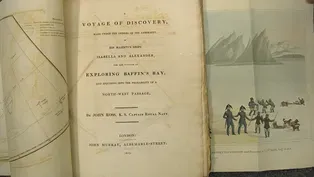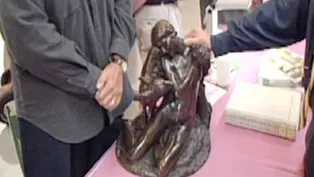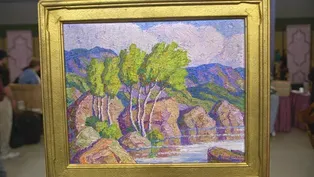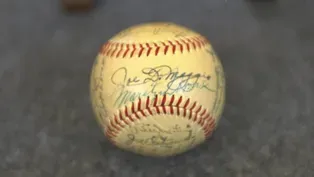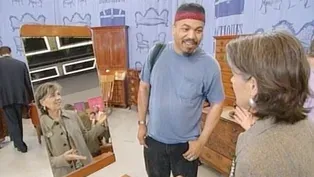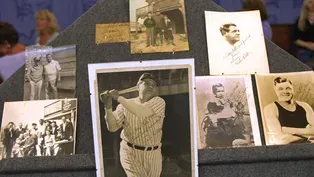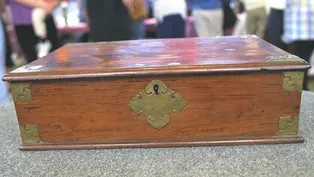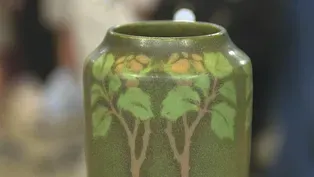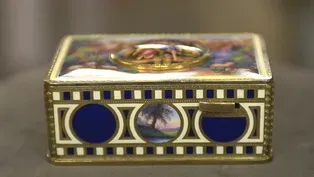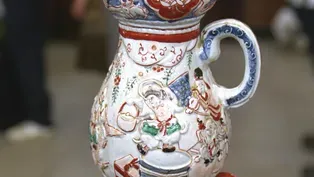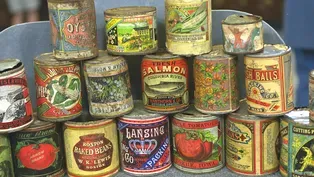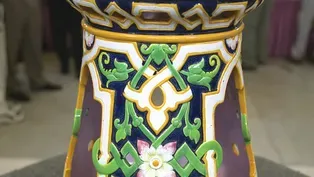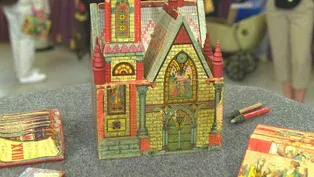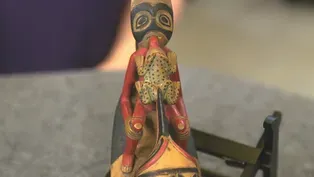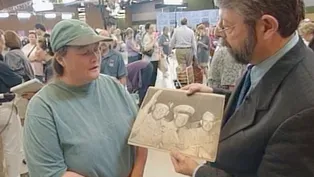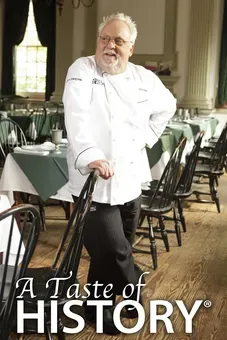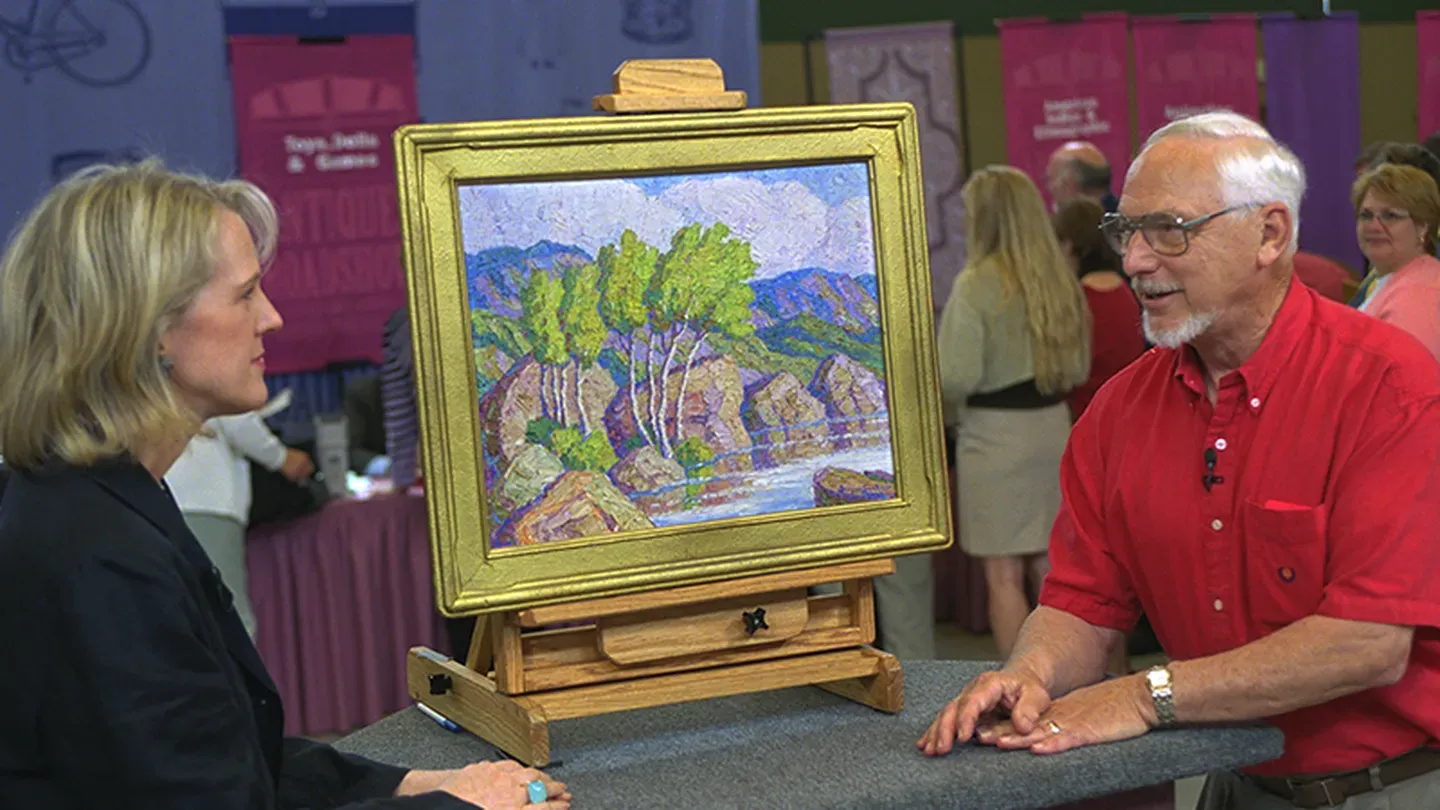

Vintage Seattle
Season 21 Episode 23 | 52m 22sVideo has Closed Captions
Uncover how appraisals from 15 years ago have held up in the antiques market.
Uncover how Seattle appraisals from 15 years ago have held up in the rising and falling antiques market. Highlights include a 1937 Birger Sandzén landscape, Babe Ruth-signed photos, and WWII work incentive posters. Have the values soared or sunk?
Problems with Closed Captions? Closed Captioning Feedback
Problems with Closed Captions? Closed Captioning Feedback
Funding for ANTIQUES ROADSHOW is provided by Ancestry and American Cruise Lines. Additional funding is provided by public television viewers.

Vintage Seattle
Season 21 Episode 23 | 52m 22sVideo has Closed Captions
Uncover how Seattle appraisals from 15 years ago have held up in the rising and falling antiques market. Highlights include a 1937 Birger Sandzén landscape, Babe Ruth-signed photos, and WWII work incentive posters. Have the values soared or sunk?
Problems with Closed Captions? Closed Captioning Feedback
How to Watch Antiques Roadshow
Antiques Roadshow is available to stream on pbs.org and the free PBS App, available on iPhone, Apple TV, Android TV, Android smartphones, Amazon Fire TV, Amazon Fire Tablet, Roku, Samsung Smart TV, and Vizio.

ANTIQUES ROADSHOW 2025 Tour!
Enter now for a chance to win free tickets to ANTIQUES ROADSHOW's 2025 Tour! Plus, see which cities we're headed to!Providing Support for PBS.org
Learn Moreabout PBS online sponsorshipHow did your mother come to be a collector of pornography, as you say?
Accidentally.
I was supposed to be at a family reunion this weekend, and I decided I couldn't pass this up.
And I didn't have a ticket, so I went and begged for one.
MARK WALBERG: In 2002, Roadshow made a second visit to Seattle.
Since then, the antiques market has had its highs and lows, but baseball collectibles have stayed strong.
Is that the case for these rare Babe Ruth photos?
We'll find out later in the show.
But first, let's take a look at this Yankees baseball with a Hollywood connection.
1953, my grandmother was dating a jazz musician who happened to be a member of Marilyn Monroe's backup band.
Marilyn decided to have a party at her house to show her appreciation to the band, and she showed up a couple of hours late, but when she came, she brought a baseball signed by the entire team, and Joe DiMaggio, and hand-signed them, and handed out about ten of them to the guests.
And this is a photograph of the party?
Yeah, and my grandmother is second from the right on the top.
And in this picture, I notice that Marilyn is holding the baseball.
And then we have a magazine right here dated 1952, and it talks about the party.
What we have here is a 1951 New York Yankees-signed team baseball.
It's got fellows like a very young Mickey Mantle, in his rookie season, and of course, it has Joe DiMaggio, the captain of the Yankees, the Yankee Clipper, on the sweet spot.
Now, as a rule of thumb, when someone not affiliated with the team signs a baseball, it dramatically decreases its value.
This baseball is beautiful and it's in great shape, and it would probably be worth around $5,000 to $7,000.
But Marilyn signed it.
And good news for you, that's the exception to the rule.
Marilyn Monroe and Joe DiMaggio are pop culture royalty, and here they both signed this phenomenal baseball, it's absolutely beautiful.
The documentation is incredible.
And I would insure it for, say, $15,000 at the very least.
Not bad?
Nope.
Not bad considering you didn't have a ticket today, did you?
No, I...
I had to sort of...
I was supposed to be at a family reunion this weekend, and I decided I couldn't pass this up, and I didn't have a ticket, so I went and begged for one.
It was worth it.
It's one of the most incredible signed baseballs I've ever seen.
Oh good.
It's magnificent and congratulations.
It's priceless to me, it's a family heirloom basically.
About 30 years ago, in my pursuits as a garage sale junkie, I found this very unusual piece.
I'd never seen anything like it before.
I thought it was Chinese.
I thought it was a funeral urn for ashes.
And then I thought it might be a tea service.
And it's been sitting on my dresser for 30 years waiting for an answer until the Roadshow came along.
It's Japanese and it's very, very early Japanese.
You're correct about it being a tea urn.
That's exactly what it was, but it was made for the Dutch export market in Japan in a very famous kiln area called Arita.
And it was done by the Dutch because what happened in China was at the end of the Ming dynasty, all the kilns closed down.
And the Dutch had to find some place to go to make their fine pieces for export to their country.
So they went into Japan and they approached Arita, and this is a very early piece.
And the reason we know this is early is-- and can probably date it from about 1670-- is the fact that it's a rather transitional piece in that it has these Japanese figures here, the seven lucky gods.
And one of them is Daikoku, which is this man right here, holding the mallet.
And he's the god of good fortune, of wealth.
So these were figures that the Japanese used in their porcelains before the Dutch came in.
And they were unsure of what to put on this porcelain.
How were they going to decorate this piece for the Dutch market?
So it's interesting in the fact that the shape of the urn is Dutch, but the Japanese were using their decorations.
So that's why we can date it from that period.
And as you say, it is for tea, a tea spigot.
You can see here, it is now a cork, but was once a probably removeable spigot.
How much did you pay for this vase?
I don't recall exactly, but I had a rule at the time that I wouldn't buy anything for more than ten dollars at a garage sale.
Wonderful.
So I'm sure I stuck to that rule.
Perhaps ten dollars then.
Yes.
The estimate would be somewhere in the neighborhood of $10,000 to $15,000 for this.
Okay.
(laughing) I'm speechless.
I bought it about 20 years ago from Blanche's Antiques in Seattle.
You bought from a very, very reputable dealer.
This is a $2,500 to $3,500 item.
I also want you to know that she was my mentor in the business.
What you've got here is like an almost entirely intact English china painting set made by the Hancock and Son Worcester Company.
I think the whole set's worth about $250 to $300.
Oh great.
Okay, it's a fun thing to have.
Sure.
Most of these are from the late 19th, early 20th century, and you have some rare ones.
Like these baby shoes with the cobalt beads.
Just a few years ago these were about $65, and now they're over $100, somewhere around $130.
MAN: Wow.
WOMAN: I brought you a teddy bear that's been in our family since probably 1900s.
It was my mom's cousin's.
She inherited him, you know, and she was an only child, a little girl that had him, so he's in good condition.
APPRAISER: Yeah, he's absolutely beautiful.
And you learned something about him today too, didn't you?
He squeaks.
Yeah, I was so shocked.
And any idea who made him at all?
Somebody told me Steiff.
Yup, they were telling you the right thing.
He originally had a button in his ear, which is now gone.
Beautiful white Steiff bear, perfect patch, shoe button eyes.
White Steiff bears are very, very rare.
And one like him, this size, this condition probably between $8,000 and $10,000.
Oh my gosh!
So you've got a good Steiff there.
Oh wow, that's... You have the best Steiff bear here today.
Great.
WOMAN: Well, it was my grandmother's.
She had received this quilt from her mother, and that the back of it was actually a contribution made by some Chinese immigrants who had been burned out of their homes at the time of the Seattle Great Fire, which was 1889.
And then she backed it with these Chinese silk handkerchiefs that they gave to her in appreciation for letting them sleep and cook in their home.
Well, it's a remarkable quilt.
And I think what, as you said, the thing that's most exciting about it is the backing of it is made with those Chinese silk handkerchiefs.
So it's just an incredible piece of Seattle history.
You and I have been looking at some of these ribbons that are embroidered into the quilt, and this is the Seattle Women's Christian Temperance Union?
Yes, she was very active.
And then this one over here is...?
It says "W.T.," which has got to be Washington Territory.
So this piece is really a time capsule in terms of your family history and also Seattle history.
Yes.
Well, it's in remarkably good condition, and I would say that the value of this piece is probably at auction somewhere around $10,000.
(gasps) (laughing): I don't believe that.
Yeah.
I don't...
I know.
Oh my goodness.
Yeah.
Absolutely, it's a very special piece.
Well, this has been in the family as long as I can remember.
It belonged to my father.
He was born in Superior, Wisconsin, in 1919.
And apparently he played with it as a child.
And other than that, that's all we know.
APPRAISER: Now, did you ever play with it?
You know, I set it up a few times in the house, but it kept falling over, so we sort of put it away.
So your father played with it around in the '20s.
When he got it, it was already an old toy.
Oh really?
Yeah.
It was made in the 1890s.
So it came down to him.
And whoever it came from, they kept it in really very good condition.
It's made by a company called the Bliss Manufacturing Company, and their specialty was lithographed paper on wood.
And it's a major category of toys that are very desirable today to modern collectors.
This is one of two churches that were made, and it's the more elaborate of the two churches that are made.
And what's wonderful about it is that it's all here.
Even every single little spire is here.
These are often missing.
You know, lithograph paper on wood toys tend to be easily damaged.
And the other interesting factor about this toy, this is what we'd call a Sunday toy.
Each one of these blocks illustrates a story from the Bible.
He would only play with it on Sunday?
That was the story.
I don't know.
As you found out, it's not that easy to play with because it's hard to put together.
Right.
And the other interesting thing I think is fascinating is that it all comes apart, as you know, and disassembles, and then it all gets put back.
Right.
This is the box it comes in.
And there's the name Bliss.
Well, as I say, this is a better-than-average example, rare with all the original pieces.
I would say on today's market at auction I would expect this toy to easily bring $2,000 to $3,000.
You're kidding me.
So you got a real treasure here.
Oh wow.
Well, it belonged to my father, so it's worth a lot more than that.
MAN: It's my mother's pornographic book collection from the late 1800s and very early 1900s.
APPRAISER: How did your mother come to be a collector of pornography, as you say?
(laughing) Accidentally.
She went back to France, Cannes in France, in 1960 and moved into a 125-year-old apartment building.
Didn't need the basement locker, which she gave to her neighbors, who brought up these books and said it's your locker, they were there, and you're the only one in the building who speaks English.
So they became hers.
And a while later I was telephoning her from Seattle, and she said, "You know, I have these pornographic books.
Should I throw them away?"
And I said, "Heavens, no."
I went back and picked them up myself.
Well, these, as you pointed out, mostly have imprints of Paris, but they were probably printed in London.
They're late 19th, early 20th century.
But this is the real gem of the collection.
Although it's undated, it has a bookseller's mark, which says 1866.
It has a Cruikshank drawing in it.
It's a very unusual one because I bought a book of Cruikshank etchings and wrote to the professor who had written it, and he had never heard of this one.
I would actually call this more sensationalism than pornography.
But just to give people a flavor of what the book is, it's a lengthy title, but I think it's worth reading.
It is.
The surprising adventures of a female husband!
Containing the whimsical amours, curious incidents, and diabolical tricks of Miss M. Hamilton, alias Mr. G. Hamilton, alias Minister Bentley, alias Dr. O'Keefe, alias Mrs. Knight, the Midwife, et cetera.
"Who married three wives and lived with each "some time undiscovered for which act she was tried "in the summer session in the county of Somerset in the year 1752, found guilty and whipped several times."
Which is what we see in the frontispiece.
It was actually printed in 1813.
And you can look down here, and why someone would have erased it, I don't know, but that's where the date appeared.
Do you have any idea who wrote the book?
Really, I don't.
It's actually a famous author, Henry Fielding.
Oh really?
Who was better known for Joseph Andrews and Tom Jones.
Now you said you looked in a Cruikshank bibliography and then spoke with an expert and couldn't find any record of this.
I did some checking as well and couldn't find any record of it.
And I suspect that this is probably not a Cruikshank etching, even though it has his name there.
He was so famous during that period, that other artists would copy his style and sign his name to give a little bit of legitimacy to the publication.
But I'm not sure that Cruikshank, while he was a little bit of a wild liver himself, would necessarily want to be associated with something quite like this.
The condition is a little water-stained, but despite that, it's such a fun item.
I certainly think at auction it would sell for between $1,500 and $2,000.
All right.
There's still an insatiable appetite for this sort of thing.
WOMAN: It was given to one of my great-great-grandparents around the turn of the century, when they lived in the town of Port Townsend.
APPRAISER: Yes?
And they both worked with the Native Americans in that area.
And as a gift, it was given to them.
I know that it is a rattle.
Correct.
And I don't know much more about it than that except I think it was ceremonial in nature.
According to my mother, it was part of the Tlingit tribe.
She's close.
Very close.
It's from a long ways north from Port Townsend.
It's from, probably from Prince Rupert in British Columbia.
Really?
It's from a tribe called the Tsimshian, and they're right at the border of Alaska and the northern part of British Columbia there.
Wow.
And you're right in assuming that it was ceremonial.
The Northwest coast peoples up there made essentially two different kinds of rattles.
Shamans had mostly a round rattle that they used in curing people.
Uh-huh.
And chiefs had rattles like this.
You're kidding.
It's a chief's rattle.
Oh my gosh.
And it's called a raven rattle.
Ooh.
And we can see here if we look on the side, this is the raven.
And we have a human figure sitting on the back of the raven.
The raven is the creator of man.
And we have this frog going from the raven through the frog into the human figure.
It's the movement of animal into man and back again.
Okay.
Also we have on the bottom, beautifully carved, this little wrapping here.
It's not original.
No, no, it... That's been added a little later.
Yes.
Every photograph we see in the 19th century, we see these are being used by chiefs, held upside down.
And the belief is it's to stop the bird, the raven from flying away.
Oh.
Unfortunately now, we're not getting the sound of the rattling because when this separated, the pebbles-- there used to be sometimes lead shot, more often just little round pebbles-- were in between these two carved halves.
So that when it was... moved, you'd get that lovely sound.
And it was quite a lovely sound.
This is probably about 1880.
Earlier rattles our gallery sold for quite a bit of money, in the excess of $50,000.
Yours, very nice, not the absolute best.
But we would expect in the neighborhood of $15,000, $18,000, perhaps $20,000.
(chuckling): Oh my God.
Still a little more than you expected, I think.
A lot more than I expected.
With the exception of this little wrapping here, condition's excellent, very beautifully carved, and a wonderful thing.
That's a Philippine betel nut box.
Betel nut is a nut that they chew in the Philippines.
Apparently it's somewhat of a narcotic.
It's a super example.
There are not a lot of collectors of betel nut boxes, but if they were around, they would all want this one.
This one is to raise money for the war effort in selling bonds.
It has a vision of Lady Liberty leading the troops, it's sexy, it's patriotic, it's heroic.
And despite its beauty, they are still very, very common.
They're not unique, but they are a part of American history.
This piece right here was put on, and I know you didn't do it.
This was done probably 100 years ago.
And what they did in the process is that they took a piece that today would have been worth $2,400.
Wow.
And now we've dropped it to $1,200.
Oh wow.
But that's okay, it's still worth $1,200.
That's true.
Well, my dad, Colonel Chester B. Hansen, was aide to General Bradley during World War II.
Who's shown here, right.
Yes, and it was taken in Washington, D.C., around 1947 by New York Times photographer George Tames.
Right.
And it was after General Bradley was made chief of staff in Washington, D.C.
Exactly, and what do we have down here?
I have Montgomery's signature, Dwight Eisenhower and General Bradley.
I think it's a great conjunction of signatures.
I mean, you know, three of the people who essentially were responsible for the winning of the war in Europe.
And this is nice because you get a good clear signature of each one.
Montgomery of Alamein, Dwight D. Eisenhower, and Omar N. Bradley.
Eisenhower's is a little rough-edged, like he was a little shaky when he made this.
Or maybe the pen didn't work too well on the photo.
But I think it's a great World War II signed photo, even though it's later than World War II in date.
Any idea what it might be worth?
Not a clue.
I'm figuring about $3,000 or $4,000, actually.
Wow.
All right.
When my grandparents passed away, we found these couple dolls and found this one in the bottom of the trunk.
Well, I understand you also said that you'd taken it apart, but couldn't find any mark on it.
Yeah, I started looking at it trying to figure out if there was a marking on it, and I didn't see anything.
Well, it was made by the Simon & Halbig firm.
And they're known for the beautiful bisques.
What's also special, he's got the original sheen to his composition body.
And thirdly, he's got these wonderful original clothes, original leather boots, nice little wool outfit, all original, original mohair wig.
So everything is just wonderful about him.
The firm started making French fashion dolls, then dolly-faced dolls, and then they went into character dolls.
And this is what we call a character doll.
Normally, they would be marked on the back, but not every one is.
So this doll is not marked, that's why you couldn't find anything.
And what makes him so special is the character face.
If you'll notice, a little moustache.
And nice molded eyebrows, beautiful eyes, and he even has little eye lines right here.
Oh yeah.
Beautiful, beautiful modeling, beautiful quality bisque.
And that makes him very, very special as a character doll by Simon & Halbig.
Would you like to guess the value?
Probably $500 something, in that area, $500, a little more?
I'll buy him, sold.
(laughing) Not really, but actually he's worth $3,000 to $4,000.
Wow.
If he was marked, you could go to the higher end, but he's definitely Simon & Halbig because of the face, and the other versions of this are marked.
And that's how we know for sure that he's a Simon & Halbig.
MAN: I got a call from a man in Philomath, Oregon.
And he said, "I've got this piece of Walrath, and it's just great and you need to have that."
And I thought, what is Walrath?
I'd never heard of it.
Never seen a piece.
Looked at it, and finally I bought it for $100.
APPRAISER: And that was how long ago?
1977.
Okay.
There's a whole series of studio potters, small producers who were working out of studios, or schools, or colleges, or basements around the time of the Arts and Crafts period.
And Frederick Walrath was one of those people.
He studied at Alfred University under Binns, the famous Binns, Charles Fergus Binns, and later went off on his own, even worked at the famous Newcomb College pottery.
But for a short while he worked in Rochester, New York, in the Mechanics Institute.
In fact, this pot has the Walrath Pottery mark on it.
It says "Walrath Pottery," and in the center is a little cartouche that's "M.I."
for Mechanics Institute.
And what he was famous for doing there was matte painting.
And the thing about matte painting that makes it very difficult, you're essentially decorating with glaze.
And what happens to glaze in the kiln is glaze gets hot and it runs down the surface of the pot.
I mean, look at the sharpness of the line going down the side of this pot.
Okay, it's very crisp.
Walrath was very, very good at managing to get these matte glazes to stay very crisp and give you very sharp detailing in his work.
Most pieces of Walrath pottery are not this large.
When they are, they tend to be decorated in bands around the top, not having elements that trail all the way to the bottom.
And they tend to be two-color pieces-- a background color, and then another color.
This is three or four colors, so this is... in so many ways, this is such a good piece of Walrath.
I've probably had 40 pieces of Walrath in 30 years, and that's probably most of what's out there.
I will show you there is one small flaw, which is really relatively minor.
It's a small chip on the base of the piece.
That's the only strike against it.
Otherwise, on every side this piece is fired perfectly.
So I'd say on a scale of one to ten you have about a nine and a half piece of Walrath.
The last one of these I had at auction was about two years ago.
It was the same shape and size, but it had a banded decoration around the top, which is not as good.
On the other hand, it didn't have that little nick on the bottom.
And we had a $3,000 to $4,000 auction estimate on it, and we got $12,000 for it.
So I would say that this is about a $10,000 to $15,000 piece of Walrath pottery on today's market at auction.
You got to be kidding me.
$10,000 to $15,000.
$10,000 to $15,000.
I'm amazed.
Go find another one, there are any more out there.
Yeah, I need a dozen of them.
MAN: In 1946, Birger Sandzén, the artist here, started a little summer art session, and I was one of the lucky few that got into that.
And I remember doing the standard drawings, and Sandzén would come through once in a while.
And the painting that I was doing was of a donkey.
And he looked at it and he said, "More paint."
And that was basically his idea was to put more paint on anything you painted.
Well, that's certainly very apropos, given the surface of this painting.
Sandzén, as I'm sure you know, was born in Sweden and moved to Lindsborg, Kansas, in 1894 to teach at Bethany College.
And like other artists in the region, like Thomas Hart Benton and Grant Wood, Midwestern artists, he was aware of more avant garde movements like cubism or futurism and modern trends like abstraction.
But he really preferred to paint a realistic view of the American landscape because he felt that that's what people could really relate to.
Right.
And he had a unique style of painting where he left a very thick layer of impasto over the entire surface.
After he visited Colorado, he brightened up his colors and his whole palette became lighter and brighter.
And this is actually a Colorado work.
Yes.
It's signed and dated 1937 in the lower right, and it's also signed and titled on the reverse, "Mountain Stream, Big Thompson Canyon in Estes Park."
Right.
His market didn't really take off until the '80s and '90s.
He was really pretty much unrecognized in the American marketplace.
And because of his unusual technique of painting, he was sort of nicknamed the American Van Gogh, but the artist always disclaimed any great influence of Van Gogh.
Uh-huh.
I think at auction, this might bring as much as $30,000 to $50,000.
Oops!
(chuckling): Oops.
Uh... No, I was thinking in the hundreds, maybe, but thousands, no.
MAN: Well, this is my uncle from Astoria, Oregon.
He went into the Army in 1917 and he was there through 1919.
He served on the American Expeditionary Forces in France.
And he was in the Lafayette Escadrille.
Okay.
Well, when you walked in this morning and I saw you in your uniform, I knew you were serious about what you brought with you.
The thing that makes it so special is this is the 103rd, the Lafayette Escadrille.
The thing that makes this so unique to me is that you've got the actual uniform on that your uncle's wearing in the photo.
In the photo, you could even see the Indian head insignia on his pocket of the 103rd Pursuit Squadron.
You're wearing the uniform on the upper sleeve that has the cockade, which indicates it's air service.
On your hat, you've got the air service badge.
It just... it's incredible.
You've got the photo album showing photos of airplanes.
If I turn the page here... One of his friends from home sent him those.
He drew those and sent them to him.
And then one other little thing here that I thought was exceptional... was these little charm bracelets.
You said he sent these to his sister?
That's correct.
Okay, this has the French Croix de Guerre, which is a medal.
Unit insignias, and then this one has flags of all the Allied nations in World War I.
So really quite a nice little group of souvenirs.
The other thing that really dazzled me the most was the insignia of the Lafayette Escadrille, the Indian head.
He's also got a German cross off of a downed German airplane.
And you said he mentions that in his diary?
He does mention that in his diary, that is correct.
His dog tags, his business card, 103rd Aero Squadron, service medals.
Just a wonderful array of items.
Let me show one last thing here.
Let's unroll this-- this is a picture of him and fellow pilots in front of the airplanes.
That's him on the far left, right under your thumb there.
Right here he's pictured with a little X under him.
I think conservatively, if this was auctioned, a group like this might fetch as much as $8,000 to $10,000.
Wow, all right.
Simply because you're dealing with a very flashy unit, collectors love this unit, and it doesn't come up for sale too often in the market.
I think it's a land grant from a father to a son-in-law.
This is very typical of 18th century legal documents.
They're big, they're on vellum.
They look very impressive, they look like they might be very, very expensive, but usually they're not.
It'd sell for about $100.
But the best thing I think you can do is to frame it and put it on your wall.
I think it would look very impressive.
APPRAISER: Okay, this is really a very wonderful Staffordshire platter.
Two- and three-color Staffordshire is hardly... you don't find it hardly at all.
It increases the value of the piece.
Now, you might think because of the mark on the back that it is Josiah Wedgwood.
It is not.
The maker is John Wedge Wood-- three names.
It's probably worth about $500.
MAN: Great.
WOMAN: This watch belonged to my father-in-law.
It's a premier watch made by Edward Howard.
It was started in about late 1850s.
In today's marketplace, a watch like this would probably be worth between $3,500 and $5,000.
My goodness.
It's just a fantastic example.
Absolutely beautiful.
You bought this in a flea market.
Right, outside of Pittsburgh.
You paid...?
$65.
$65.
And what do you know about it?
I collect Deco, we collect Deco furniture, so it was like a machine-age design, which was one reason we were interested in it.
Sure.
I think it's part of a suite, a bedroom set or something like that, I'm not sure.
I actually think it's probably a hall pier table and hall mirror.
You can sort of adjust this thing.
You thought it was a designer?
Yeah, I thought maybe Kem Weber or Donald Deskey, but...
I think it's much more of a mass-produced item than that, although it's got great sleek lines to it.
You know in the Deco period, they're making all these wild forms-- vanities, they're doing the cigarette tables, they're doing bars, they're doing all sorts of things.
I think this is part of it as sort of a Deco for the masses, if you will.
Okay.
Do you notice there's a number on the back of this thing.
That's why we know it's mass produced.
I think it's a great find for $65.
I mean, you know I'd see it in a shop at $600 to $800 easily.
Really?
Yeah, oh I think so, yeah.
WOMAN: Oh, I've had it since about '93.
It belonged to my aunt, and she left it to me when she died.
This is all hand-painted enamels.
And most people in the trade would describe this as being Continental, they're from Germany.
They made little boxes like this in Austria and France, and it probably dates from the late 19th century, 1880s, 1890s.
Sometimes even after the turn of the century.
And inside they have a mechanical clock movement that drives the sound of the music and everything.
And on the top, I think I want everybody to see how beautiful the enamelwork is.
This has a scene of two young lovers out in the forest on the top of it.
All this beautiful cobalt blue and white enamel in the background along the edges, and it has little landscapes and little inset panels on the sides as you go around.
Just exquisite work.
I think it's gorgeous.
It is gorgeous.
Is value an important thing to you?
Is this something you're going to keep in your family?
Oh, I will never sell it.
Well, we felt like value was going to be somewhere in the $3,000 to $5,000 range.
That's a lot.
(laughing) Well, let's listen to it one time, what do you think?
Sure.
(chirping) Now, isn't that darling?
That's beautiful.
How in the world did they get the wings to move like that and the beak?
It's an automaton.
It has a little mechanical movement inside of it.
It's so tiny though.
(chirping) APPRAISER: Well, this is an artist who's got a very strong connection with Pennsylvania and is one of a group of artists who are amongst the hottest collecting areas in American paintings just now, the Pennsylvania Impressionists, who were based around the area of New Hope.
WOMAN: Uh-huh.
Walter Emerson Baum, he was born in Sellersville in Pennsylvania.
And I think you had one or two questions.
I just was wondering what makes a painting more valuable than another painting.
Right.
Right.
I should point out first of all, we've got the little signature here.
But he's also been good enough to... sign it in the back here.
And what helps-- to answer your question-- is the fact that we know where it is now, it's a farm in Center Valley.
And people like to know-- particularly collectors of this work-- where it's located.
The Center Valley in Pennsylvania?
Yeah, absolutely.
And the other thing that helps this painting along is the fact that it's a snow scene.
Because they tend to be the most coveted paintings by Walter Emerson Baum.
The thing to remember with him is that he was one of the most prolific of the Pennsylvania Impressionists.
So he's painted a lot of... Oh yeah.
Now, that can be a bit of a problem.
Because he was also very variable.
And when you have artists who are prolific and variable, it can quite often lead to fakes.
Now, don't look so worried because there's no problem with this one, it's a very nice bona fide Baum painting.
And Baum certainly has a lot going for him at the moment.
And this is a nice little jewel-like one.
It's quite small.
Mm-hmm.
But it's going to clean up beautifully.
It's actually quite dirty.
I don't know if you noticed that.
No, I didn't.
It's not a personal criticism of housekeeping or anything like that, but over a period of time... Well, I'm sure it hasn't been cleaned in... 20 or 30 years.
It hasn't, yeah.
If you're thinking of holding onto it, then I would advise you to have it cleaned.
But if it's something you're thinking of selling, you're actually better to leave it in the condition that it's in and let someone else take that on.
It's got all the ingredients that a collector of Baum would want to see.
I would expect it to fetch, I think comfortably $4,000 to $6,000.
Wow.
Wow.
Particularly in the current market, they're very, very sought after.
Boy, that's... that's quite a bit of money.
You're surprised at that.
Yes.
But you mentioned you had other... you're not so keen on this one, is that right?
Well, I do, I like it.
I think the thing that I don't like about it is the framing.
If I were to get it reframed, I mean would that be okay or would that take away the value or should I leave it in this frame?
You know, I am inclined, I always recommend that you try and keep the original frame where possible.
I think it's nice to do that.
Well, I'll learn to love it the way it looks.
Absolutely.
Well, it's a flag that belonged to my grandfather.
It was given to him by his mother, who made the flag.
And he flew it from his dormitory window at Dartmouth College during the Civil War.
And this is his mother, is that right?
This is the lady that made the flag, my great-grandmother.
And that's her husband.
And this is my great-grandfather.
Having the silhouette of the person that made it is really quite unusual and quite rare.
This was handed down to you.
It was handed down to my mother and then to me.
And I've had it for 25 years now.
It's a rare flag, 31 stars.
California was the 31st state that came into the Union in 1850.
So that dates the flag pre-Civil War.
It's all hand-stitched, made by your grand... great-grandmother.
And there was an auction a few weeks ago in which stars-and-stripes flags brought unbelievable prices.
So I think that the flag market has really gone up.
And this has got more history to it than I think most of the flags in that auction.
It's just grand.
Do you have an idea of what this might be worth?
With the silhouettes?
I have not... not a clue.
It's never been looked at.
Well, I think, probably with the silhouettes and the family history, you've got a $15,000 to $20,000 flag here.
But I think that you should take it to a textile conservator and really have it restored, because it's fraying and it needs some attention.
You probably can find somebody locally through a local museum.
What's interesting about this tile really is the technique.
All of this decoration is put on by a technique we call tube lining.
And it's rather like icing a cake.
These little drops are all done by squeezing it out of a bag.
I think it's worth at least $700 or $800.
I use it every Christmas for eggnog.
All right, well, it's actually for something a little different than eggnog, but it's sort of something you would use at the 19th hole.
And it's by Derby Silver-Plated Company, made around 1925.
It's very kind of Art Deco.
I acquired it eight years ago, and a gentleman in Tacoma owned it.
So rather than being just a model of a schooner, it really was meant to be played with and enjoyed.
Well, actually I had gone to a birthday party outside of San Francisco, and after that party I was going through a small town, went into an antique store and saw this.
Just sort of fell in love with the piece, thought it was a good price, and so snatched it up.
Oh, that's terrific.
And just out of curiosity, what did you pay for the piece?
$2,000 for the piece.
$2,000.
It is signed on the bottom of the plateau, and it's also dated.
Have you any idea what you think that it might be worth?
Hopefully more than the $2,000 I paid for it.
(laughing) Well, truthfully I can say I think you really got a deal.
Oh good.
You really got a deal.
It's worth between $15,000 and $20,000.
All right!
It's a fantastic buy.
Thank you.
You're more than welcome.
My pleasure.
Thank you.
Oh, yeah, that's pretty wonderful.
MAN: Well, as you can see, these are all World War II manufacturing posters.
A family friend of ours was the artist, named Ben Deler.
We met him in a bar actually in Seattle and we became very good friends over the years.
And when he passed on a little over 20 years ago, he left his entire estate to my younger brother.
He had no family and we were his adopted family.
He went to the same art school that Normal Rockwell did, and he was very good friends with Walter Lantz, who was the artist who did Woody Woodpecker.
Woody Woodpecker, indeed.
First of all, they're called work incentive posters, and they were printed by the Douglas Aircraft Company to hang in the factory to sort of encourage the workers to be more productive, to be safer on the job, not to waste materials and generally to produce more.
I want to tell you that they are worth more now than they were before September 11th.
Really?
And these posters are so patriotic and they instill such a sense of pride, such a sense of patriotism.
I want to draw your attention to just this one.
"Every punch rings for liberty."
And it's a pun on punching because they're punching in the time clock.
It really has a strong emotional appeal.
Now it's rare to see such a huge set of these, and I've never actually seen any of them even individually before.
You have 25 of them, and I'm going to tell you in light of their great message, some is "don't waste materials," "be at work on time," "be safe," "don't spread secrets," "work hard," "wear your safety goggles" and so on.
I believe at auction, for the collection of 25 posters that you have, I would put an estimate on them of $3,000 to $4,000 for the group.
And I would expect conceivably that they would even sell higher than that.
MAN: I found these in an old mining town in Colorado, actually town's Leadville.
I buy old houses and fix them up, and I did that for many years.
This was the only one I ever found a stash of cans that were left there by the workers who built the house.
Part of the house was made out of log, and the workers actually hewed the logs out right on the job site.
And this was done in 1882.
That the wood chips and parts under the house were like six inches thick.
And when they would eat their lunches, they just threw the cans under instead of taking them somewhere else.
If they landed on the wood chips, they were preserved.
If they landed in the dirt, they were a little pile of rust.
That's amazing.
But I found actually 66 cans under this house.
But the mice had eaten the labels off of about 25 of them.
So these are... these are your best examples.
Those are the best ones.
I do have some duplicates of a few.
But most of them are one of a kind.
And there's three that have dates on them.
Right.
This is one of them actually that has the date.
Yes, that has the oldest date, registered 1876.
Actually you found some other documentation.
This is interesting.
There's a photograph here from a history book that shows miners tossing cans.
And this particular can right here, this bean can is exactly the same as this Boston baked bean can, is that correct?
Yes, it is.
I just found that a few months ago.
I was... it's the first time I've ever even seen any of these cans.
The tin can label applied to cans in this manner was first done in 1876.
Is that correct?
That's right.
According to your research.
From other people that I've talked to, they say about the earliest they've ever seen is around 1890.
So it's kind of exciting to have one that's 14 years older than that.
For a paper label, right.
I've taken it to museums, I've shown them to different people.
They just shake their heads and say, "We've never seen anything like this."
Yeah.
No, and I haven't either.
Well, first of all, the graphics are just fantastic.
They are.
And the colors have been preserved beautifully.
Chromolithography is the process that allowed this vivid color.
But usually most of the chromolithography we see has survived in books where the pages have been closed and no light has gotten to them.
Some of these cans would sell in the range of $400 to $800 apiece.
That's...
If you average out the collection, I was doing some quick calculating.
You have to be looking at a collection that should sell in the range for $10,000 to $14,000.
Pretty good for discarded food cans.
Yeah.
Thanks for bringing them down.
Thank you.
WOMAN: Well, these were given to us from my father.
This is my Great-Uncle Herb, Aunt Gert, and they had a restaurant in Greenwood Lake, New York.
APPRAISER: Right.
And Babe Ruth was my uncle and aunt's friend.
And over the years, they got this accumulation of pictures which hung in the back of the bar in the restaurant.
These all hung in the Hilltop Restaurant?
Right.
Wow, how many years did Gertie and Herby own the restaurant?
Possibly from maybe the late '30s to the early '60s.
He had a huge grand circle of friends, just like your aunt and uncle, Gertie and Herby.
And he sought out those friends as well as sick children.
He was big-hearted, he was generous, he was a wonderful person, as you can see in these photos.
The photo with Gertie and Herby, the photo with your father, and this one, which I love, which is Babe with... this is your father in knickers, right?
The last year he wore knickers.
Right.
And your uncle.
If I can remember correctly, he took that picture to school with him and he created somewhat of a small riot.
And he was told not to come back with that picture anymore.
When we look at photos, we look to see three different things.
If you look at this photo, which I love, "To my pals Gertrude and Herbert from Babe Ruth."
This is a very large photo.
This is probably 14 by 11.
And that's a big size.
That's going to have a lot more value than, say, a two-by-three photo.
And with someone like larger than life like Babe Ruth, you wouldn't expect anything else.
The second thing we look at is authenticity and provenance because Babe Ruth signed a lot and there are lots of legitimate signatures, but unfortunately, there are also some signatures that are not authentic over the years.
His wife signed for him at different times, his secretary, clubhouse boys.
The next thing we look at is how unusual they are.
I've seen... this is a very famous photo of Babe Ruth as a three-year-old.
But I've never seen a Babe Ruth as a three-year-old photo inscribed, and what an inscription this is.
"What a nice little boy at age three, but now wow, to my pals, Herby and Gertie, Babe Ruth."
And then here's a photo at 24.
And then the mystery photo, which you told me no one knows-- "to my little girlfriend Joan, from Babe Ruth"-- who that could possibly be.
To preserve them, you keep them in Mylar containers, away from the light just as you told me.
Value-wise, I think that they would sell for between $25,000 and $30,000 for the group.
(chuckling) So what would Herby and Gertie say about this?
"Sell 'em!"
(laughing) 25 years ago, my favorite cousin called u Well, 25 years ago, my favorite cousin called up on the telephone.
Said she was cleaning out the attic after her mother's death.
And did I want a family chest that had been in that attic about 75 years, at least.
And as she described it, it was a chest that Edward Doty brought over on the Mayflower in 1620.
And as I'm a direct descendant of Edward Doty, she thought I might like it.
That was a no-brainer.
I began to worry about it a little bit and thought, gee, I better, you know, insure this thing.
But to insure it you have to get an appraisal.
So my attorney got in the act and he knew somebody up in New York City, and he wrote that gentleman a letter.
And he wrote that gentleman a letter on December 15, 1984, and the gentleman's name was Lark Mason.
Yeah, so that was me, that was the first time.
So 1984, and I recommended at the time that you contact-- which is the next step...
The Peabody Museum, Asian Art division, is it?
Exactly.
Bill Sargent runs.
And so I sent him full details, and pictures and all kinds of things about it.
Got back a most interesting letter from him, which you have seen.
Which says, obviously of Asian extraction, the chest itself.
But if it's Chinese brass work and came over on the Mayflower in 1620, how did that happen?
Right, well, that's why you came here today.
That's why I came here today.
So we're here today to solve a problem that has existed since the last 100 years anyway, maybe even since 1620. Who knows.
First, when you open up the box, on the inside, there's this panel and two papers that have been attached to it that basically go through, they give your family history.
What I'd like to draw attention to, though, is some elements on this box that I think are very important to try and ascertain the date.
Number one, when you open it up, you get a very vibrantly grained type of wood.
The type of wood that this is made of is huanghuali.
It was a wood that was available in southern China, beginning in about 1580.
And from that point forward, you find furniture made of it.
These types of hinges were hinges that were employed by the Dutch, and the Dutch were very much involved in China at an early period of time.
Not all the wood is huanghuali.
The base is a wood called tielimu.
It's a different type of wood.
Dutch boxes like this were made throughout Southeast Asia, but they weren't made of tielimu and huanghuali.
Those were available in one spot, really, which was Canton.
Ah.
Now, as you look at the outside, trying to come up with an idea of the date.
The box itself is a Baroque design.
So 17th century design.
You see these wonderful brass mounts, which are stipple-engraved?
Mm-hmm.
We call this a bat wing brass.
The brasses are Rococo, which you don't get into until about 1720s, 1730s, '40s.
What I noticed here in your family history is there's somebody who moved to Duchess County in New York.
Yes, mm-hmm.
Duchess County was an area where there was a tremendously large population of Dutch.
The Dutch were engaged in the China trade.
They were.
But my sense is that this probably did not come over on the Mayflower, but it could easily have been something that was picked up by your ancestor while he was in Duchess County in the 1720s, which would fit perfectly with the brasses.
Mm-hmm.
It would fit with the basic design and the information we have that we know about the China trade.
Even though it might be a 1720, 1740 piece, this would still be one of the earliest examples of documented Chinese furniture here in the West, if not the earliest, which is really great.
The value, it's immaterial, maybe $2,000 to $3,000.
Thank you so much, I really appreciate it.
That solves a mystery that's been going on for all these years.
Wonderful.
No one knew the answer.
WALBERG: I'm Mark Walberg.
Thanks for watching.
See you next time on Antiques Roadshow.
Appraisal: 1813 Fielding's "Female Husband" Book
Video has Closed Captions
Appraisal: 1813 Fielding's "Female Husband" Book, from Vintage Seattle. (3m 20s)
Appraisal: 1819 Ross's "Voyage of Discovery" Book
Video has Closed Captions
Appraisal: 1819 Ross's "Voyage of Discovery" Book, from Vintage Seattle. (1m 3s)
Appraisal: 1911 J.M. Boyriven Bronze
Video has Closed Captions
Appraisal: 1911 J.M. Boyriven Bronze, from Vintage Seattle. (59s)
Appraisal: 1911 White Steiff Bear
Video has Closed Captions
Appraisal: 1911 White Steiff Bear, from Vintage Seattle. (50s)
Appraisal: 1930 Walter Emerson Baum Painting
Video has Closed Captions
Appraisal: 1930 Walter Emerson Baum Painting, from Vintage Seattle. (2m 50s)
Appraisal: 1937 Birgir Sandzén Landscape
Video has Closed Captions
Appraisal: 1937 Birgir Sandzén Landscape, from Vintage Seattle. (2m 36s)
Appraisal: 1951 Yankees & Monroe-signed Baseball
Video has Closed Captions
Appraisal: 1951 Yankees & Monroe-signed Baseball, from Vintage Seattle. (2m 26s)
Appraisal: 31-Star Flag & Silhouettes, ca. 1850
Video has Closed Captions
Appraisal: 31-Star Flag & Silhouettes, ca. 1850, from Vintage Seattle. (2m 4s)
Appraisal: Art Deco Pier Table & Hall Mirror
Video has Closed Captions
Appraisal: Art Deco Pier Table & Hall Mirror, from Vintage Seattle. (1m 14s)
Appraisal: Babe Ruth-signed Photographs
Video has Closed Captions
Appraisal: Babe Ruth-signed photographs, from Vintage Seattle. (2m 48s)
Appraisal: Chinese Export Chest, ca. 1730
Video has Closed Captions
Appraisal: Chinese Export Chest, ca. 1730, from Vintage Seattle. (4m 29s)
Appraisal: Diamond & Synthetic Sapphire Ring, ca. 1925
Video has Closed Captions
Appraisal: Diamond & Synthetic Sapphire Ring, ca. 1925, from Vintage Seattle. (1m 3s)
Appraisal: Frederick Walrath Pottery Vase, ca. 1910
Video has Closed Captions
Appraisal: Frederick Walrath Pottery Vase, ca. 1910, from Vintage Seattle. (2m 47s)
Appraisal: German Music Box, ca. 1885
Video has Closed Captions
Appraisal: German Music Box, ca. 1885, from Vintage Seattle. (2m 1s)
Appraisal: Japanese Arita Tea Urn, ca. 1670
Video has Closed Captions
Appraisal: Japanese Arita Tea Urn, ca. 1670, from Vintage Seattle. (2m 25s)
Appraisal: Late 19th-Century Tin Can Labels
Video has Closed Captions
Appraisal: Late 19th-Century Tin Can Labels, from Vintage Seattle. (2m 48s)
Appraisal: Minton Conservatory Seat, ca. 1863
Video has Closed Captions
Appraisal: Minton Conservatory Seat, ca. 1863, from Vintage Seattle. (33s)
Appraisal: R. Bliss Mfg. Co. Toy Church, ca. 1890
Video has Closed Captions
Appraisal: R. Bliss Mfg. Co. Toy Church, ca. 1890, from Vintage Seattle. (2m 18s)
Appraisal: Silk-embroidery Crazy Quilt, ca. 1890
Video has Closed Captions
Appraisal: Silk-embroidery Crazy Quilt, ca. 1890, from Vintage Seattle. (1m 57s)
Appraisal: Simon & Halbig Character Doll, ca. 1885
Video has Closed Captions
Appraisal: Simon & Halbig Character Doll, ca. 1885, from Vintage Seattle. (1m 52s)
Appraisal: Tsimshian Chief's Rattle, ca. 1880
Video has Closed Captions
Appraisal: Tsimshian Chief's Rattle, ca. 1880, from Vintage Seattle. (3m 2s)
Appraisal: World War I 103rd Aero Squadron Collection
Video has Closed Captions
Appraisal: World War I 103rd Aero Squadron Collection, from Vintage Seattle. (2m 33s)
Appraisal: World War II Photograph of Allied Military Leader
Video has Closed Captions
Appraisal: World War II Photograph of Allied Military Leaders, from Vintage Seattle. (1m 20s)
Providing Support for PBS.org
Learn Moreabout PBS online sponsorshipSupport for PBS provided by:
Funding for ANTIQUES ROADSHOW is provided by Ancestry and American Cruise Lines. Additional funding is provided by public television viewers.




